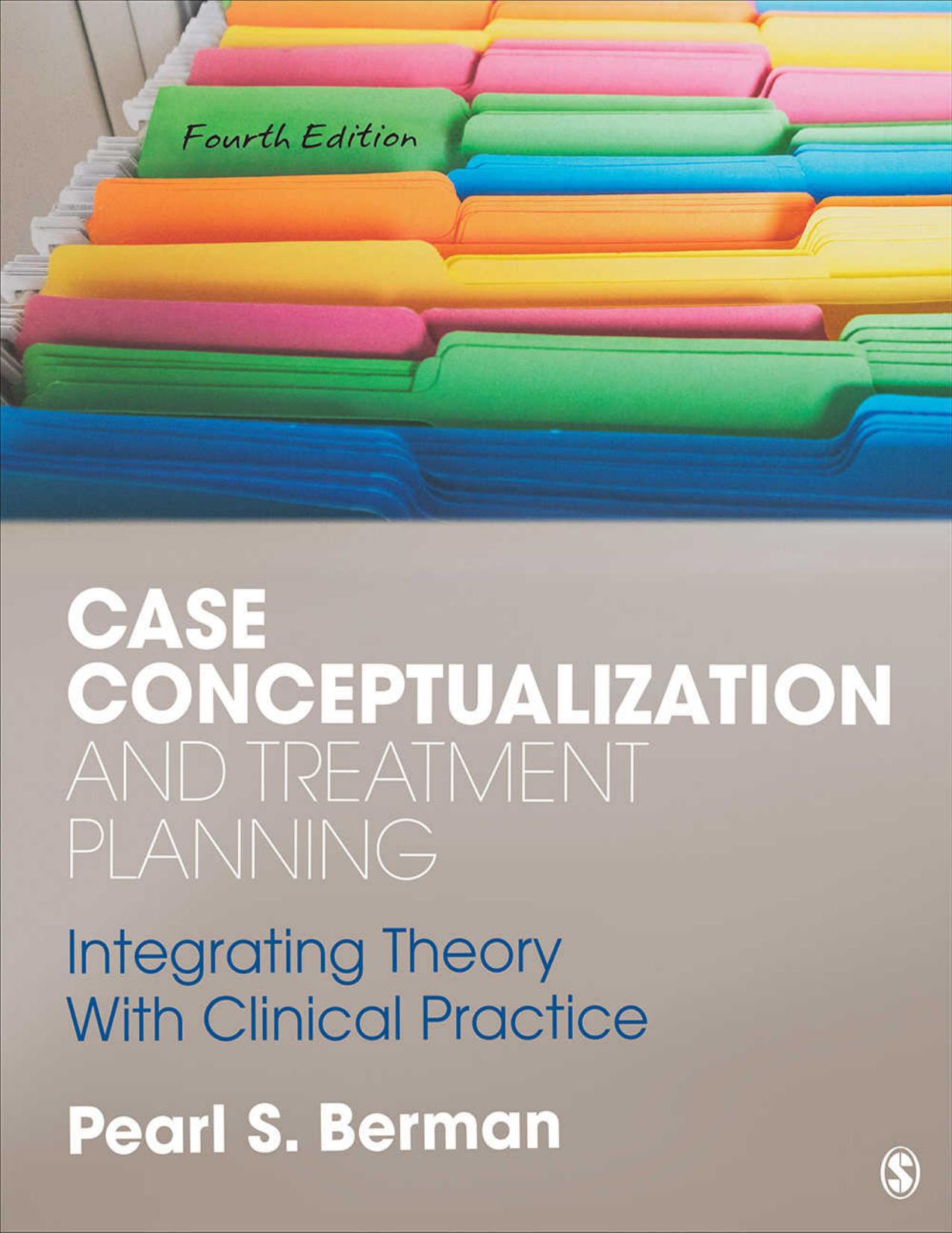Case Conceptualization and Treatment Planning Integrating Theory With Clinical Practice 4th edition by Pearl Susan Berman ISBN 1506331394 9781506331393
$70.00 Original price was: $70.00.$35.00Current price is: $35.00.
Instant download Case Conceptualization and Treatment Planning Integrating Theory With Clinical Practice 4th Pearl Susan Berman after payment
Case Conceptualization and Treatment Planning Integrating Theory With Clinical Practice 4th edition by Pearl Susan Berman – Ebook PDF Instant Download/Delivery: 1506331394, 9781506331393
Full download Case Conceptualization and Treatment Planning Integrating Theory With Clinical Practice 4th edition after payment

Product details:
ISBN 10: 1506331394
ISBN 13: 9781506331393
Author: Pearl Susan Berman
Case Conceptualization and Treatment Planning: Integrating Theory With Clinical Practice teaches students in counseling, psychotherapy, and clinical psychology how to develop the case conceptualization and treatment planning skills necessary to help clients achieve change. Author Pearl S. Berman provides client interviews and sample case studies in each chapter along with detailed steps for practice and developing treatment plans. Chapters conclude with questions that engage students in critical thinking about the complexity of human experiences. The updated and expanded Fourth Edition includes cutting-edge issues in trauma-informed care; responsiveness to development across the lifespan; integration of issues relevant to intersectionality of oppression; and evidence-based practice.
Case Conceptualization and Treatment Planning Integrating Theory With Clinical Practice 4th Table of contents:
SECTION ONE
Chapter 1 • Developing Case Conceptualizations and Treatment Plans
-
Selecting a Theoretical Perspective
-
Reason for Referral
-
Case History
-
Developing Your Theoretical Understanding of Pat
-
Key Features in Developing a Case Conceptualization
-
Key Features in Developing a Treatment Plan
-
Developing a Flexible Writing Style
-
Examples of Premises and Treatment Plan Styles
-
Premise 1: Assumption-Based Style
-
Treatment Plan 1: Assumption-Based Style
-
Premise 2: Symptom-Based Style
-
Treatment Plan 2: Symptom-Based Style
-
Premise 3: Interpersonally Based Style
-
Treatment Plan 3: Interpersonally Based Style
-
Premise 4: Historically Based Style
-
Treatment Plan 4: Historically Based Style
-
-
Conclusions
-
Recommended Resources
Chapter 2 • Violence and Trauma
-
Introduction to the Impact of Violence and Trauma
-
Violence and Minors
-
Family Context
-
Peer Context
-
Dating Violence
-
Sexual Offenses
-
Campus Sexual Assault
-
Community and Situational Contexts
-
Polyvictimization
-
-
Impact of Victimization on Children and Youth
-
Protective Factors
-
-
Violence and Adults
-
Physical Violence
-
Perpetrators of IPV
-
Stalking
-
Psychological Violence
-
Sexual Violence
-
Polyvictimization
-
-
Violence Against Older Adults
-
Physical Violence
-
Sexual Violence
-
Financial Exploitation
-
Co-occurrence
-
Polyvictimization
-
Impact of Victimization
-
Perpetrators
-
Role of Cognitive Capacity
-
Living Arrangements
-
Issues in Reporting
-
-
Violence Across the Life Span
-
Perpetrators of Violence Across the Life Span
-
Prison
-
-
Prevention of Violence and Trauma
-
Resilience or Positive Adaptation to Violence Exposure
-
Promoting Resilience
-
Treatment of Victims and Perpetrators
-
Summary
-
Final Words
-
Red Flag Guidelines for Trauma-Informed Care
-
Self-Analysis Guidelines
-
Recommended Resources
-
Books
-
Websites
-
Videos
-
Chapter 3 • Introduction to the Complexity of Human Experience
-
Intersectionality of Domains of Oppression
-
How Might Understanding Intersectionality Influence Treatment?
-
Red Flag Guidelines for Intersectionality
-
Self-Analysis Guidelines
-
Chapters Highlighting Different Domains of Complexity
-
Recommended Resources
-
Books
-
Websites
-
Videos
-
Chapter 4 • The Complexity of Human Experience: Domain of Development
-
Minors
-
Early Childhood (Approximately Ages 4–7)
-
Middle Childhood (Approximately Ages 7–12)
-
Adolescence (Approximately Ages 12–19)
-
-
Emerging and Early Adulthood
-
Middle Adulthood
-
Older Adulthood
-
Red Flag Developmental Guidelines
-
Self-Analysis Guidelines
-
Chapters Where Age Is Highlighted
-
Recommended Resources
-
Books
-
Websites
-
Videos
-
Chapter 5 • The Complexity of Human Experience: Gender
-
Definitional Challenges
-
Biology
-
Estimates of Gender Prevalence
-
Gender and Households
-
Gender and Employment
-
Gender Identity
-
Gender Role Stereotypes
-
Learning Gender Roles
-
The Female Gender Role Stereotype
-
The Male Gender Role Stereotype
-
-
Gender Roles and Parenting
-
Gender Role Transitions Across the Life Span
-
Gender Role Stereotypes and Psychological Well-Being
-
Men
-
LGBTQI
-
Women
-
Sexual Assault and Gender
-
The Gender-Informed Clinician
-
Gender Stereotypes and Societies
-
Red Flag Gender Guidelines
-
Self-Analysis Guidelines
-
Chapters Highlighting Gender
-
Recommended Resources
-
Books
-
Websites
-
Videos
-
Chapter 6 • The Complexity of Human Experience: Race and Ethnicity
-
Census Data
-
Brief History
-
African-Americans
-
Native American-Indians and Alaska Natives
-
Hispanic or Latino and Latina-Americans
-
White-Americans/European-Americans
-
-
The Racial Divide
-
Clinical Implications
-
Red Flag Racial and Ethnic Guidelines
-
Self-Analysis Guidelines
-
Chapters Highlighting Race and Ethnicity
-
Recommended Resources
-
Books
-
Websites
-
Videos
-
Chapter 7 • The Complexity of Human Experience: Sexual Orientation
-
Sexual Minority Stresses During Childhood and Adolescence
-
School System
-
Sexual Orientation and Sex Education in the Schools
-
-
Sexual Minority Stresses in Adulthood
-
Same-Sex Couples
-
Asexuality and Relationships
-
Sexual Orientation and Parenting
-
Sexual Orientation and the Military
-
Sexual Orientation and Psychological Health
-
-
Red Flag Sexual Orientation Guidelines
-
Self-Analysis Guidelines
-
Chapters Highlighting Sexual Orientation
-
Recommended Resources
-
Books
-
Websites
-
Videos
-
Chapter 8 • The Complexity of Human Experience: Socioeconomic Status
-
Income Inequality and Socioeconomic Status
-
Class, Power, and Socioeconomic Status
-
Households and Socioeconomic Status
-
Education and Socioeconomic Status
-
Neighborhoods and Socioeconomic Status
-
Health Care and Socioeconomic Status
-
Physical and Psychological Health and Socioeconomic Status
-
Legal System and Socioeconomic Status
-
Resilience and Socioeconomic Status
-
Red Flag Socioeconomic Guidelines
-
Self-Analysis Guidelines
-
Chapters Highlighting Socioeconomic Status
-
Recommended Resources
-
Books
-
Websites
-
Videos
-
Chapter 9 • Introduction to Clinical Chapters
-
Trauma-Informed Care
-
Research on Treatment Effectiveness
-
Evidence-Based Treatments (EBT)
-
Evidence-Based Programs and Practices
-
Red Flag Guidelines for Using Evidence-Based Professional Practice
-
Common Factors Approach to Effective Treatment
-
Red Flag Guidelines Utilizing Common Factors to Promote Positive Outcomes
-
Skills of Master Clinicians
-
Red Flag Master Clinician Guidelines
-
Conclusions
-
Recommended Resources
-
Books
-
Websites
-
SECTION TWO
Chapter 10 • Behavioral Case Conceptualizations and Treatment Plans
-
Role of the Clinician
-
Evidenced-Based Practice
-
Evidence-Based Treatments
-
Common Factors in Effective Treatment
-
Master Clinician Strategies
-
Case Application: Integrating the Domain of Gender
-
Interview With Jeff (J) From a Behavioral Perspective
-
Behavioral Case Conceptualization of Jeff: Assumption-Based Style
-
Behavioral Treatment Plan: Assumption-Based Style
-
Behavioral Case Conceptualization of Jeff: Historically Based Style
-
Behavioral Treatment Plan: Historically Based Style
-
Practice Case for Student Conceptualization: Integrating the Domain of Age
-
Information Received From Brief Intake
-
Interview With Kevin (K) From a Behavioral Perspective
-
Exercises for Developing a Case Conceptualization of Kevin
-
Recommended Resources
-
Books
-
Websites
-
Videos
-
Chapter 11 • Cognitive Case Conceptualizations and Treatment Plans
-
Role of the Clinician
-
Evidenced-Based Practice
-
Evidence-Based Treatments
-
Common Factors in Effective Treatment
-
Master Clinician Strategies
-
Case Application: Integrating the Domain of Gender
-
Interview With Marie (M) From a Cognitive Perspective
-
Cognitive Case Conceptualization of Marie: Assumption-Based Style
-
Cognitive Treatment Plan: Assumption-Based Style
-
Cognitive Case Conceptualization of Marie: Symptom-Based Style
-
Cognitive Treatment Plan: Symptom-Based Style
-
Practice Case for Student Conceptualization: Integrating the Domain of Sexual Orientation
-
Information Received From Phone Intake
-
Interview With Eric (E) From a Cognitive Perspective
-
Exercises for Developing a Case Conceptualization of Eric
-
Recommended Resources
-
Books
-
Websites
-
Videos
-
Chapter 12 • Cognitive-Behavioral Case Conceptualizations and Treatment Plans
-
Role of the Clinician
-
Evidenced-Based Practice
-
Evidence-Based Treatments
-
Common Factors in Effective Treatment
-
Master Clinician Strategies
-
Case Application: Integrating the Domain of Socioeconomic Status
-
Interview With Ann (A) Using Mindfulness-Based Cognitive-Behavioral Treatment
-
Cognitive-Behavioral Case Conceptualization of Ann: Assumption-Based Style
-
Cognitive-Behavioral Treatment Plan: Assumption-Based Style
-
Cognitive-Behavioral Case Conceptualization of Ann: Interpersonally Based Style
-
Cognitive-Behavioral Treatment Plan: Interpersonally Based Style
-
Practice Case for Student Conceptualization: Integrating the Domain of Age
-
Information Received From Phone Intake
-
Interview With Darla (D) From a Cognitive-Behavioral Perspective
-
Exercises for Developing a Case Conceptualization of Darla
-
Recommended Resources
-
Books
-
Websites
-
Videos
-
People also search for Case Conceptualization and Treatment Planning Integrating Theory With Clinical Practice 4th :
diagnosis case conceptualization and treatment planning
cbt case conceptualization and treatment planning example
case conceptualization and treatment planning pdf
case conceptualization and treatment planning example
case conceptualization and treatment planning 4th edition pdf
Tags: Pearl Susan Berman, Case Conceptualization, Treatment Planning, Clinical Practice


